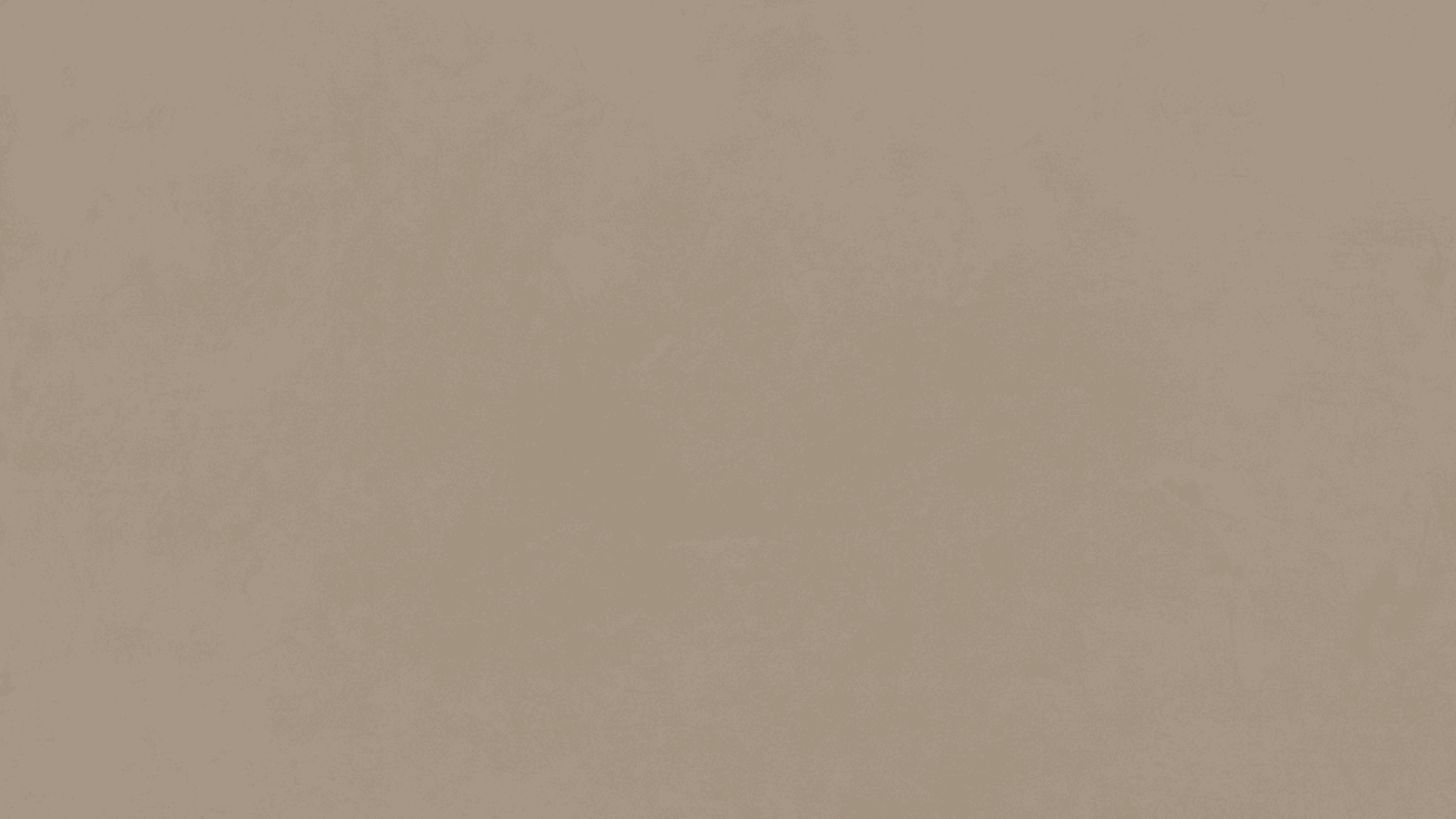
Sunflower
Designing an online community for design students
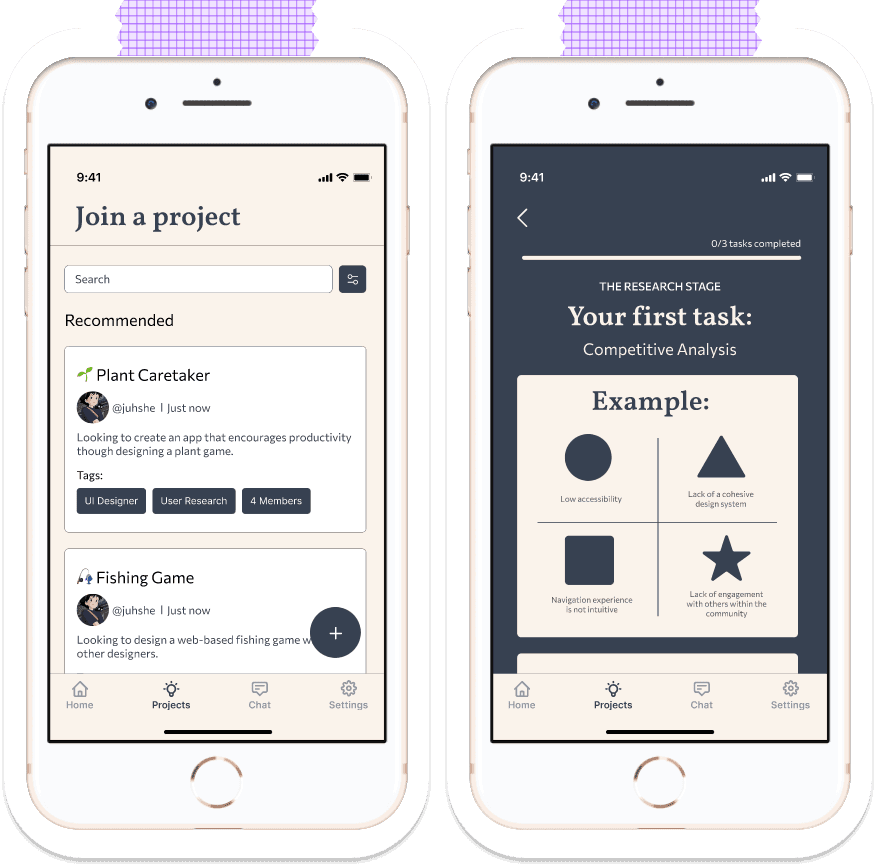
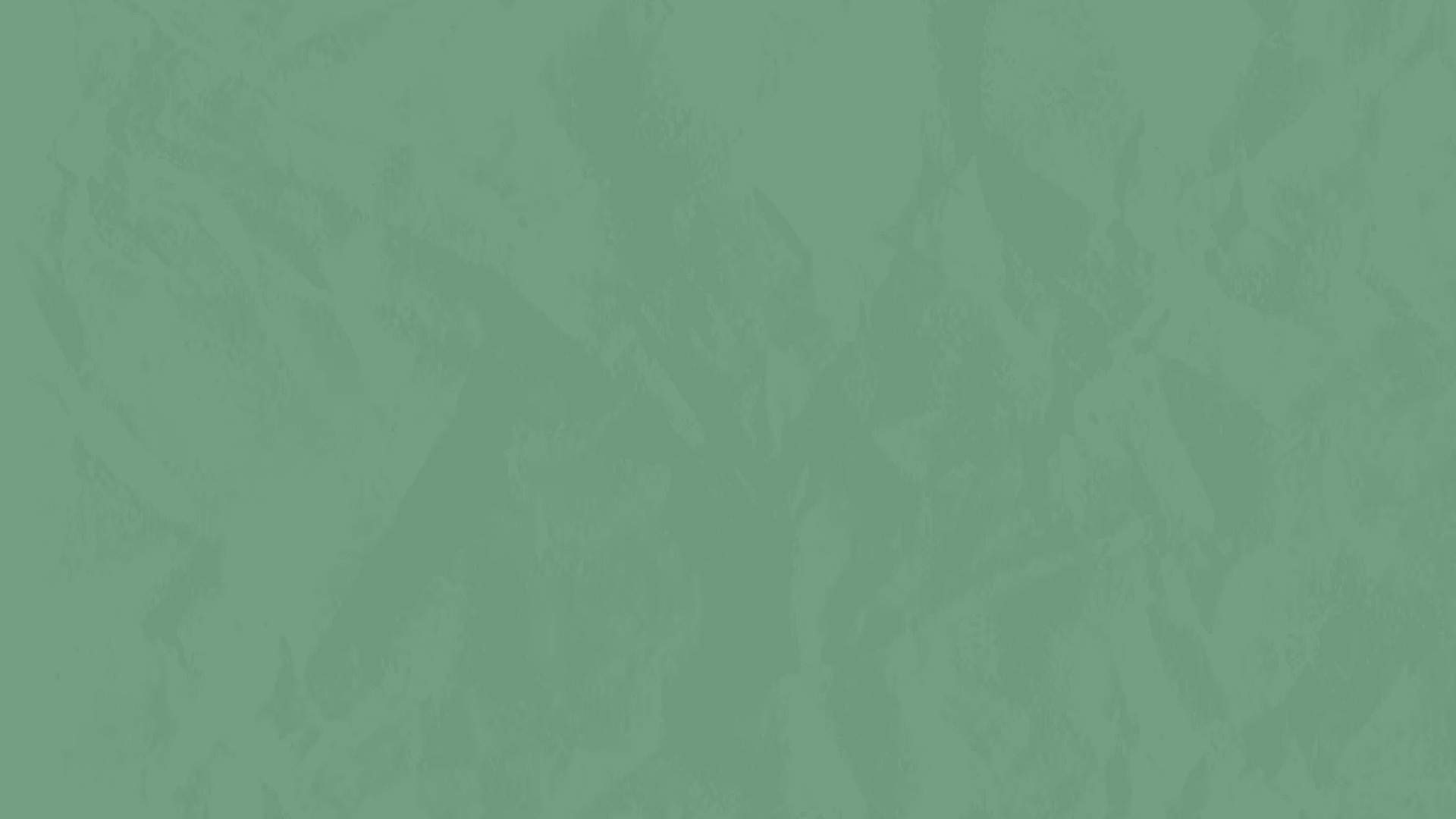
Overview
Overview
Overview
Overview
Overview
Overview
My team and I entered UCLA ACM's "I for Design" designathon and brought home third place under the UX Track! Together, we designed "Sunflower," an app that brings design students together through collaboration. The prompt was to design a website or app that will help connect the design community at your campus.
My team and I entered UCLA ACM's "I for Design" designathon and brought home third place under the UX Track! Together, we designed "Sunflower," an app that brings design students together through collaboration. The prompt was to design a website or app that will help connect the design community at your campus.
My team and I entered UCLA ACM's "I for Design" designathon and brought home third place under the UX Track! Together, we designed "Sunflower," an app that brings design students together through collaboration. The prompt was to design a website or app that will help connect the design community at your campus.
My team and I entered UCLA ACM's "I for Design" designathon and brought home third place under the UX Track! Together, we designed "Sunflower," an app that brings design students together through collaboration. The prompt was to design a website or app that will help connect the design community at your campus.
My team and I entered UCLA ACM's "I for Design" designathon and brought home third place under the UX Track! Together, we designed "Sunflower," an app that brings design students together through collaboration. The prompt was to design a website or app that will help connect the design community at your campus.
My team and I entered UCLA ACM's "I for Design" designathon and brought home third place under the UX Track! Together, we designed "Sunflower," an app that brings design students together through collaboration. The prompt was to design a website or app that will help connect the design community at your campus.
Role
Product Designer
UX Researcher
Duration
5 days
Team
Jessie Lin (Product Designer)
THE PROBLEM
THE PROBLEM
THE PROBLEM
THE PROBLEM
THE PROBLEM
THE PROBLEM
Design clubs are exclusive
Design clubs are exclusive
Design clubs are exclusive
Design clubs are exclusive
Design clubs are exclusive
Design clubs are exclusive
In the beginning of our first years of college, Jessie and I experienced difficulties with club recruitment - it felt nearly impossible to join a UX design club due to the amount of competition to even land an interview with a club. Based on our past experiences, we wanted to design a community-based solution that was inclusive of all skill levels. Below is a chart of 5 of our friends' general experiences with different design clubs on campus.
In the beginning of our first years of college, Jessie and I experienced difficulties with club recruitment - it felt nearly impossible to join a UX design club due to the amount of competition to even land an interview with a club. Based on our past experiences, we wanted to design a community-based solution that was inclusive of all skill levels. Below is a chart of 5 of our friends' general experiences with different design clubs on campus.
In the beginning of our first years of college, Jessie and I experienced difficulties with club recruitment - it felt nearly impossible to join a UX design club due to the amount of competition to even land an interview with a club. Based on our past experiences, we wanted to design a community-based solution that was inclusive of all skill levels. Below is a chart of 5 of our friends' general experiences with different design clubs on campus.
In the beginning of our first years of college, Jessie and I experienced difficulties with club recruitment - it felt nearly impossible to join a UX design club due to the amount of competition to even land an interview with a club. Based on our past experiences, we wanted to design a community-based solution that was inclusive of all skill levels. Below is a chart of 5 of our friends' general experiences with different design clubs on campus.
In the beginning of our first years of college, Jessie and I experienced difficulties with club recruitment - it felt nearly impossible to join a UX design club due to the amount of competition to even land an interview with a club. Based on our past experiences, we wanted to design a community-based solution that was inclusive of all skill levels. Below is a chart of 5 of our friends' general experiences with different design clubs on campus.
In the beginning of our first years of college, Jessie and I experienced difficulties with club recruitment - it felt nearly impossible to join a UX design club due to the amount of competition to even land an interview with a club. Based on our past experiences, we wanted to design a community-based solution that was inclusive of all skill levels. Below is a chart detail
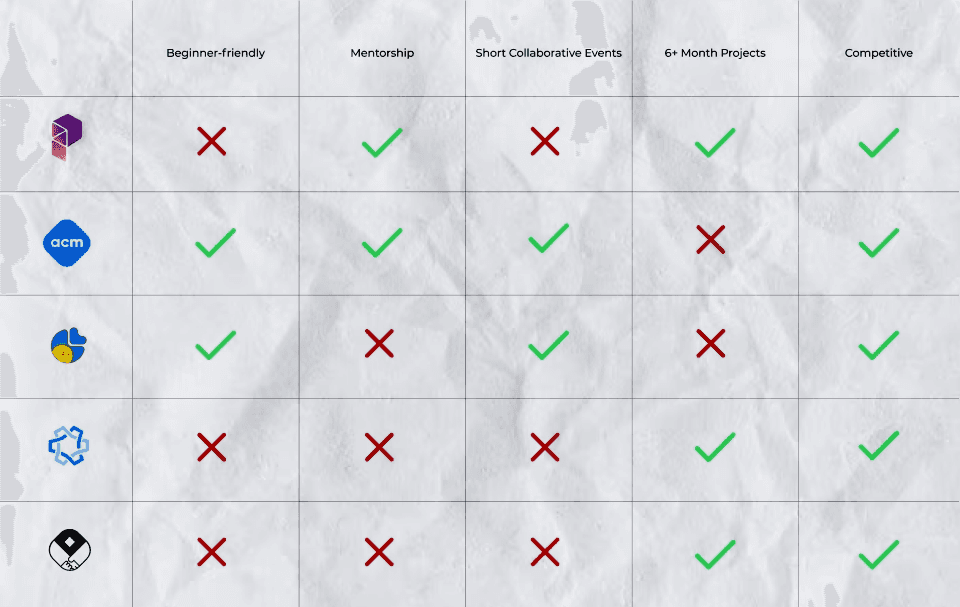









RESEARCH
Understanding our audience
Understanding our audience
Understanding our audience
Understanding our audience
Understanding our audience
Understanding our audience
Our chosen method of user research was to send out surveys to as many product designers on campus as possible within a day, so we could gather our target audience’s first-hand experiences with learning UX design to cater our product towards their needs. Based on our interview results, we identified a lack of collaborative spaces on campus because clubs were too competitive to join, and campus events dedicated towards designing products tend to have too short of a timeline to develop a full case study.
From our surveys, we found that:
• 37.5% of designers were very engaged with campus clubs
• 75% of designers enjoyed & partook in collaboration
• 75% had difficulty finding a design community on campus
• Different methods of collaboration were used across the board
After conducting a total of 16 surveys, we analyzed our findings through affinity mapping to take note of any connections between our participants' needs and feelings surrounding the campus's design community. This helped us to develop and visualize potential solutions.
Our chosen method of user research was to send out surveys to as many product designers on campus as possible within a day, so we could gather our target audience’s first-hand experiences with learning UX design to cater our product towards their needs. Based on our interview results, we identified a lack of collaborative spaces on campus because clubs were too competitive to join, and campus events dedicated towards designing products tend to have too short of a timeline to develop a full case study.
From our surveys, we found that:
• 37.5% of designers were very engaged with campus clubs
• 75% of designers enjoyed & partook in collaboration
• 75% had difficulty finding a design community on campus
• Different methods of collaboration were used across the board
After conducting a total of 16 surveys, we analyzed our findings through affinity mapping to take note of any connections between our participants' needs and feelings surrounding the campus's design community. This helped us to develop and visualize potential solutions.
Our chosen method of user research was to send out surveys to as many product designers on campus as possible within a day, so we could gather our target audience’s first-hand experiences with learning UX design to cater our product towards their needs. Based on our interview results, we identified a lack of collaborative spaces on campus because clubs were too competitive to join, and campus events dedicated towards designing products tend to have too short of a timeline to develop a full case study.
From our surveys, we found that:
• 37.5% of designers were very engaged with campus clubs
• 75% of designers enjoyed & partook in collaboration
• 75% had difficulty finding a design community on campus
• Different methods of collaboration were used across the board
After conducting a total of 16 surveys, we analyzed our findings through affinity mapping to take note of any connections between our participants' needs and feelings surrounding the campus's design community. This helped us to develop and visualize potential solutions.
Our chosen method of user research was to send out surveys to as many product designers on campus as possible within a day, so we could gather our target audience’s first-hand experiences with learning UX design to cater our product towards their needs. Based on our interview results, we identified a lack of collaborative spaces on campus because clubs were too competitive to join, and campus events dedicated towards designing products tend to have too short of a timeline to develop a full case study.
From our surveys, we found that:
• 37.5% of designers were very engaged with campus clubs
• 75% of designers enjoyed & partook in collaboration
• 75% had difficulty finding a design community on campus
• Different methods of collaboration were used across the board
After conducting a total of 16 surveys, we analyzed our findings through affinity mapping to take note of any connections between our participants' needs and feelings surrounding the campus's design community. This helped us to develop and visualize potential solutions.
Our chosen method of user research was to send out surveys to as many product designers on campus as possible within a day, so we could gather our target audience’s first-hand experiences with learning UX design to cater our product towards their needs. Based on our interview results, we identified a lack of collaborative spaces on campus because clubs were too competitive to join, and campus events dedicated towards designing products tend to have too short of a timeline to develop a full case study.
From our surveys, we found that:
• 37.5% of designers were very engaged with campus clubs
• 75% of designers enjoyed & partook in collaboration
• 75% had difficulty finding a design community on campus
• Different methods of collaboration were used across the board
After conducting a total of 16 surveys, we analyzed our findings through affinity mapping to take note of any connections between our participants' needs and feelings surrounding the campus's design community. This helped us to develop and visualize potential solutions.
Our chosen method of user research was to send out surveys to as many product designers on campus as possible within a day, so we could gather our target audience’s first-hand experiences with learning UX design to cater our product towards their needs. Based on our interview results, we identified a lack of collaborative spaces on campus because clubs were too competitive to join, and campus events dedicated towards designing products tend to have too short of a timeline to develop a full case study.
From our surveys, we found that:
• 37.5% of designers were very engaged with campus clubs
• 75% of designers enjoyed & partook in collaboration
• 75% had difficulty finding a design community on campus
• Different methods of collaboration were used across the board
After conducting a total of 16 surveys, we analyzed our findings through affinity mapping to take note of any connections between our participants' needs and feelings surrounding the campus's design community. This helped us to develop and visualize potential solutions.





Affinity Map and How-Might-We's
Affinity Map and How-Might-We's
Affinity Map and How-Might-We's
Affinity Map and How-Might-We's
Affinity Map and How-Might-We's
Affinity Map and How-Might-We's
User personas
User personas
User personas
User personas
User personas
User personas
Using our survey findings, we also created two general user personas based on UX design students to help us empathize with our users, especially because we didn't have raw user quotes to work with.
Using our survey findings, we also created two general user personas based on UX design students to help us empathize with our users, especially because we didn't have raw user quotes to work with.
Using our survey findings, we also created two general user personas based on UX design students to help us empathize with our users, especially because we didn't have raw user quotes to work with.
Using our survey findings, we also created two general user personas based on UX design students to help us empathize with our users, especially because we didn't have raw user quotes to work with.
Using our survey findings, we also created two general user personas based on UX design students to help us empathize with our users, especially because we didn't have raw user quotes to work with.
Using our survey findings, we also created two general user personas based on UX design students to help us empathize with our users, especially because we didn't have raw user quotes to work with.










BRAINSTORMING
BRAINSTORMING
BRAINSTORMING
BRAINSTORMING
BRAINSTORMING
BRAINSTORMING
Testing different solutions
Testing different solutions
Testing different solutions
Testing different solutions
Testing different solutions
Testing different solutions
We came up with some design solutions that addressed both the prompt and student designers' concerns, while weighing their pros and cons before deciding on our final idea.
We came up with some design solutions that addressed both the prompt and student designers' concerns, while weighing their pros and cons before deciding on our final idea.
We came up with some design solutions that addressed both the prompt and student designers' concerns, while weighing their pros and cons before deciding on our final idea.
We came up with some design solutions that addressed both the prompt and student designers' concerns, while weighing their pros and cons before deciding on our final idea.
We came up with some design solutions that addressed both the prompt and student designers' concerns, while weighing their pros and cons before deciding on our final idea.
We came up with some design solutions that addressed both the prompt and student designers' concerns, while weighing their pros and cons before deciding on our final idea.
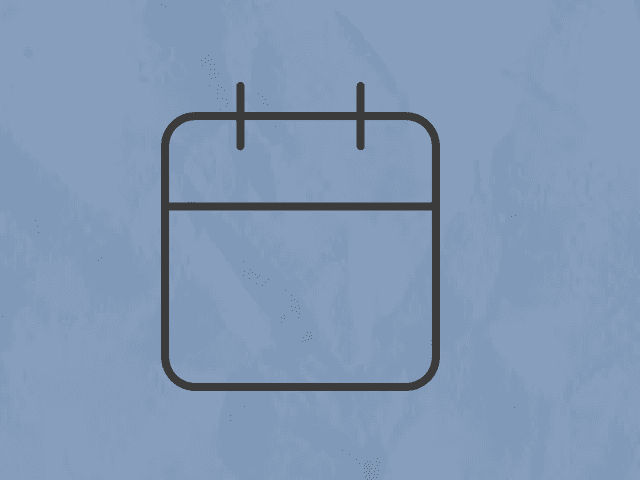




Calendar app
A calendar for club and campus events related to design workshops, speaker events, networking events, etc.
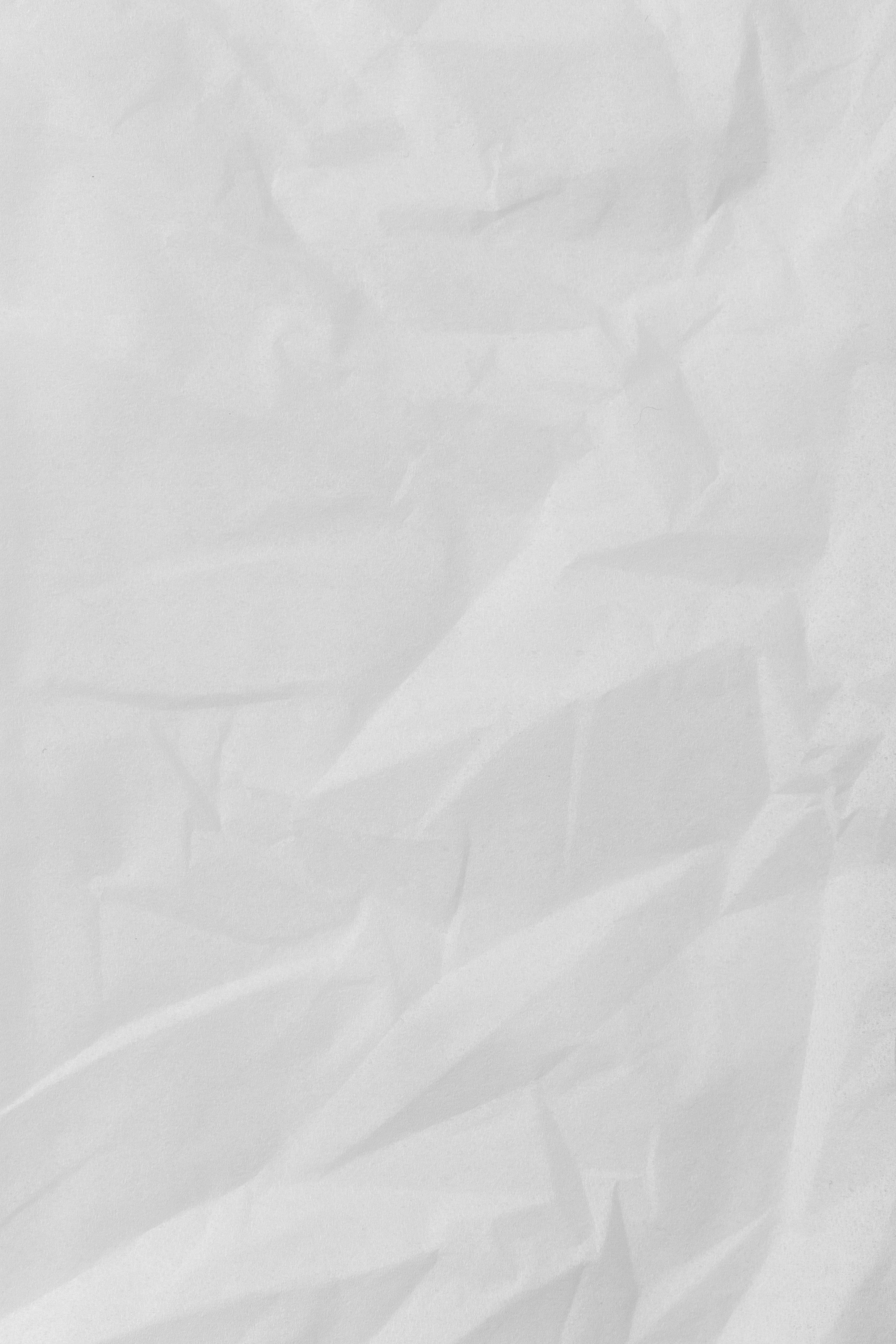
Cons: Less opportunities for collaboration through the app; workshops tends to be repetitive, so little opportunities for growth as a designer.

Cons: Less opportunities for collaboration through the app; workshops tends to be repetitive, so little opportunities for growth as a designer.

Cons: Less opportunities for collaboration through the app. workshops tends to be repetitive, so little opportunities for growth as a designer.
Cons: Less opportunities for collaboration through the app. workshops tends to be repetitive, so little opportunities for growth as a designer.

Cons: Less opportunities for collaboration through the app. workshops tends to be repetitive, so little opportunities for growth as a designer.

Cons: Less opportunities for collaboration through the app. workshops tends to be repetitive, so little opportunities for growth as a designer.

Cons: Less opportunities for collaboration through the app. workshops tends to be repetitive, so little opportunities for growth as a designer.
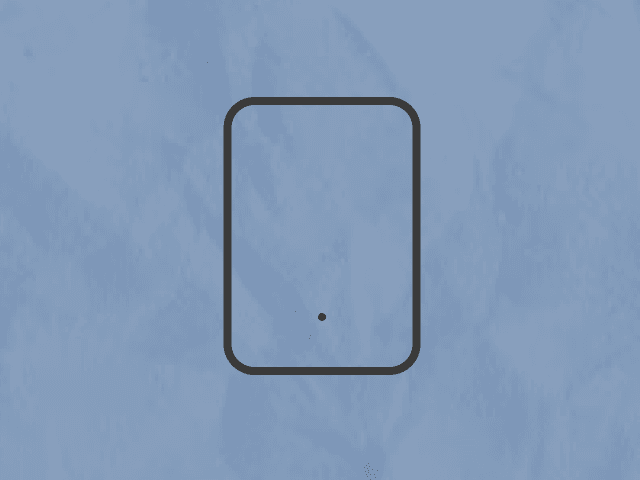




A social app
A social app for finding and pairing design students with other design students to work and grow together through UX design projects.

Cons: Issues may arise when students don't do their part of the task.
Cons: Issues may arise when students don't do their part of the task.

Cons: Issues may arise when students don't do their part of the task.

Cons: Issues may arise when students don't do their part of the task.

Cons: Issues may arise when students don't do their part of the task.

Cons: Issues may arise when students don't do their part of the task.
The winning idea
The winning idea
The winning idea
The winning idea
The winning idea
The winning idea
After discussing with a mentor and 3 other design students, we came to the agreement that the social media app would be the best solution of our two solutions, as it would directly allow student designers to communicate and connect with others who have similar passions. Both parties could grow together as designers through working on projects together.
After discussing with a mentor and 3 other design students, we came to the agreement that the social media app would be the best solution of our two solutions, as it would directly allow student designers to communicate and connect with others who have similar passions. Both parties could grow together as designers through working on projects together.
After discussing with a mentor and 3 other design students, we came to the agreement that the social media app would be the best solution of our two solutions, as it would directly allow student designers to communicate and connect with others who have similar passions. Both parties could grow together as designers through working on projects together.
After discussing with a mentor and 3 other design students, we came to the agreement that the social media app would be the best solution of our two solutions, as it would directly allow student designers to communicate and connect with others who have similar passions. Both parties could grow together as designers through working on projects together.
After discussing with a mentor and 3 other design students, we came to the agreement that the social media app would be the best solution of our two solutions, as it would directly allow student designers to communicate and connect with others who have similar passions. Both parties could grow together as designers through working on projects together.
After discussing with a mentor and 3 other design students, we came to the agreement that the social media app would be the best solution of our two solutions, as it would directly allow student designers to communicate and connect with others who have similar passions. Both parties could grow together as designers through working on projects together.
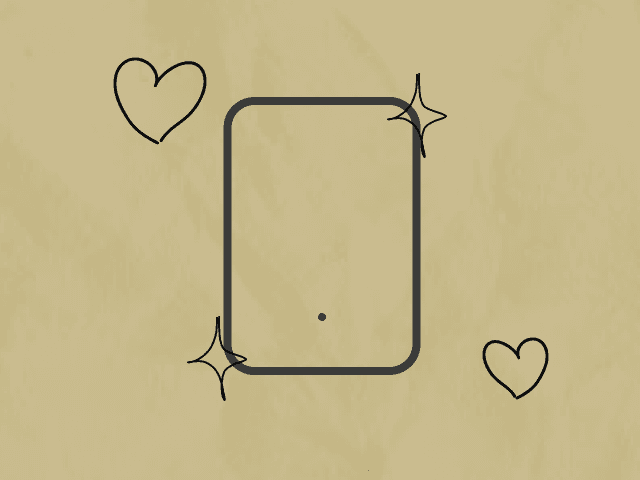




A social app
A social app for finding and pairing design students with other design students to work and grow together through UX design projects.









DESIGN
Key features to build
Key features to build
Key features to build
Key features to build
Key features to build
Key features to build
From the users' pain points and my notes from my competitive analysis, I designed several flows with our wireframes, including navigating how a user could join a project with other designers. This helped us to design wireframes consisting of our main features.
From the users' pain points and my notes from my competitive analysis, I designed several flows with our wireframes, including navigating how a user could join a project with other designers. This helped us to design wireframes consisting of our main features.
From the users' pain points and my notes from my competitive analysis, I designed several flows with our wireframes, including navigating how a user could join a project with other designers. This helped us to design wireframes consisting of our main features.
From the users' pain points and my notes from my competitive analysis, I designed several flows with our wireframes, including navigating how a user could join a project with other designers. This helped us to design wireframes consisting of our main features.
From the users' pain points and my notes from my competitive analysis, I designed several flows with our wireframes, including navigating how a user could join a project with other designers. This helped us to design wireframes consisting of our main features.
From the users' pain points and my notes from my competitive analysis, I designed several flows with our wireframes, including navigating how a user could join a project with other designers. This helped us to design wireframes consisting of our main features.





Onboarding Flow
Onboarding Flow
Onboarding Flow
Onboarding Flow
Onboarding Flow
Onboarding Flow





Join-a-project flow
Join-a-project flow
Join-a-project flow
Join-a-project flow
Join-a-project flow
Join-a-project flow
USABILITY TESTING
USABILITY TESTING
USABILITY TESTING
USABILITY TESTING
USABILITY TESTING
USABILITY TESTING
Making iterative changes
Making iterative changes
Making iterative changes
Making iterative changes
Making iterative changes
Making iterative changes
We tested the app with our mentor and 3 student designers to ensure that the product's experience was seamless, while making iterative changes along the way.
We tested the app with our mentor and 3 student designers to ensure that the product's experience was seamless, while making iterative changes along the way.
We tested the app with our mentor and 3 student designers to ensure that the product's experience was seamless, while making iterative changes along the way.
We tested the app with our mentor and 3 student designers to ensure that the product's experience was seamless, while making iterative changes along the way.
We tested the app with our mentor and 3 student designers to ensure that the product's experience was seamless, while making iterative changes along the way.
We tested the app with our mentor and 3





CHANGE #1
Our user testers noted that the questionnaire felt endless, and it would be nice to see the amount of questions in total. To remedy this, I designed a progress bar for each screen throughout the questionnaire.
CHANGE #2
It wasn't immediately obvious to our user testers that certain design vocabulary words were clickable. I designed it so that specific words leading to a link/ pop-up had clearer indication of this function by changing the colors of the text according to our brand guidelines and adding a little "?" icon.










CHANGE #3
I redesigned the entire "Join a project" page because users indicated that they would have liked to search and find a variety of projects, other than the recommended projects. Changes included a search bar, a filter system, and more categories to browse through.
CHANGE #4
After my decision to include a filter system, I designed a "Filtered Search" page, so users can have direct control over what projects they'd like to view from their homepage.





THE PRODUCT
The submitted design
The submitted design
The submitted design
The submitted design
The submitted design
The submitted design
We won 3rd place 😮
We won 3rd place 😮
We won 3rd place 😮
We won 3rd place 😮
We won 3rd place 😮
We won 3rd place 😮





View Prototype
NEXT STEPS
NEXT STEPS
NEXT STEPS
NEXT STEPS
NEXT STEPS
NEXT STEPS
Considerations
Considerations
Considerations
Considerations
Considerations
Considerations
• Explore ways of connecting designers to other
designers, rather than projects
• Conduct more user interviews
• Design more intriguing and clear empty states
• Design more screens dedicated to error prevention
• Better adhere to WCAG standards
• Considering building product on a desktop experience for easier workflow
• Explore ways of connecting designers to other
designers, rather than projects
• Conduct more user interviews
• Design more intriguing and clear empty states
• Design more screens dedicated to error prevention
• Better adhere to WCAG standards
• Considering building product on a desktop experience for easier workflow
• Explore ways of connecting designers to other
designers, rather than projects
• Conduct more user interviews
• Design more intriguing and clear empty states
• Design more screens dedicated to error prevention
• Better adhere to WCAG standards
• Considering building product on a desktop experience for easier workflow
• Explore ways of connecting designers to other
designers, rather than projects
• Conduct more user interviews
• Design more intriguing and clear empty states
• Design more screens dedicated to error prevention
• Better adhere to WCAG standards
• Considering building product on a desktop experience for easier workflow
• Explore ways of connecting designers to other
designers, rather than projects
• Conduct more user interviews
• Design more intriguing and clear empty states
• Design more screens dedicated to error prevention
• Better adhere to WCAG standards
• Considering building product on a desktop experience for easier workflow
We tested the app with our mentor and 3
Measuring success
Measuring success
Measuring success
Measuring success
Measuring success
Measuring success
If this project were to be built, we would measure the following metrics:
• The number of successful projects and content uploaded
• Test user satisfaction through a combination of surveys and interviews
• The number of registrations and user retention
If this project were to be built, we would measure the following metrics:
• The number of successful projects and content uploaded
• Test user satisfaction through a combination of surveys and interviews
• The number of registrations and user retention
If this project were to be built, we would measure the following metrics:
• The number of successful projects and content uploaded
• Test user satisfaction through a combination of surveys and interviews
• The number of registrations and user retention
If this project were to be built, we would measure the following metrics:
• The number of successful projects and content uploaded
• Test user satisfaction through a combination of surveys and interviews
• The number of registrations and user retention
If this project were to be built, we would measure the following metrics:
• The number of successful projects and content uploaded
• Test user satisfaction through a combination of surveys and interviews
• The number of registrations and user retention
We tested the app with our mentor and 3

TAKEAWAYS
Always seek feedback
Always seek feedback
My first takeaway is to always seek feedback throughout the entire design process. Fortunately, this designathon experience provided us with opportunities to seek advice and feedback from more experienced peers. I would have liked to have taken advantage of this opportunity more, especially during the research process.
My first takeaway is to always seek feedback throughout the entire design process. Fortunately, this designathon experience provided us with opportunities to seek advice and feedback from more experienced peers. I would have liked to have taken advantage of this opportunity more, especially during the research process.
Don't stick with the 1st solution
Don't stick with the 1st solution
The first solution is never the perfect one. It's important to generate any feasible ideas along the way and take note of what worked and what didn't. Design is an iterative process.
The first solution is never the perfect one. It's important to generate any feasible ideas along the way and take note of what worked and what didn't. Design is an iterative process.

TAKEAWAYS
Always seek feedback
My first takeaway is to always seek feedback throughout the entire design process. Fortunately, this designathon experience provided us with opportunities to seek advice and feedback from more experienced peers. I would have liked to have taken advantage of this opportunity more, especially during the research process.
Don't stick with the 1st solution
The first solution is never the perfect one. It's important to generate any feasible ideas along the way and take note of what worked and what didn't. Design is an iterative process.

TAKEAWAYS
Always seek feedback
My first takeaway is to always seek feedback throughout the entire design process. Fortunately, this designathon experience provided us with opportunities to seek advice and feedback from more experienced peers. I would have liked to have taken advantage of this opportunity more, especially during the research process.
Don't stick with the 1st solution
The first solution is never the perfect one. It's important to generate any feasible ideas along the way and take note of what worked and what didn't. Design is an iterative process.

TAKEAWAYS
Always seek feedback
My first takeaway is to always seek feedback throughout the entire design process. Fortunately, this designathon experience provided us with opportunities to seek advice and feedback from more experienced peers. I would have liked to have taken advantage of this opportunity more, especially during the research process.
Don't stick with the 1st solution
The first solution is never the perfect one. It's important to generate any feasible ideas along the way and take note of what worked and what didn't. Design is an iterative process.

TAKEAWAYS
Always seek feedback
My first takeaway is to always seek feedback throughout the entire design process. Fortunately, this designathon experience provided us with opportunities to seek advice and feedback from more experienced peers. I would have liked to have taken advantage of this opportunity more, especially during the research process.
Don't stick with the 1st solution
The first solution is never the perfect one. It's important to generate any feasible ideas along the way and take note of what worked and what didn't. Design is an iterative process.
Let's chat!
My inbox is always open for a chat about new projects, games, or design. ♡
Contact